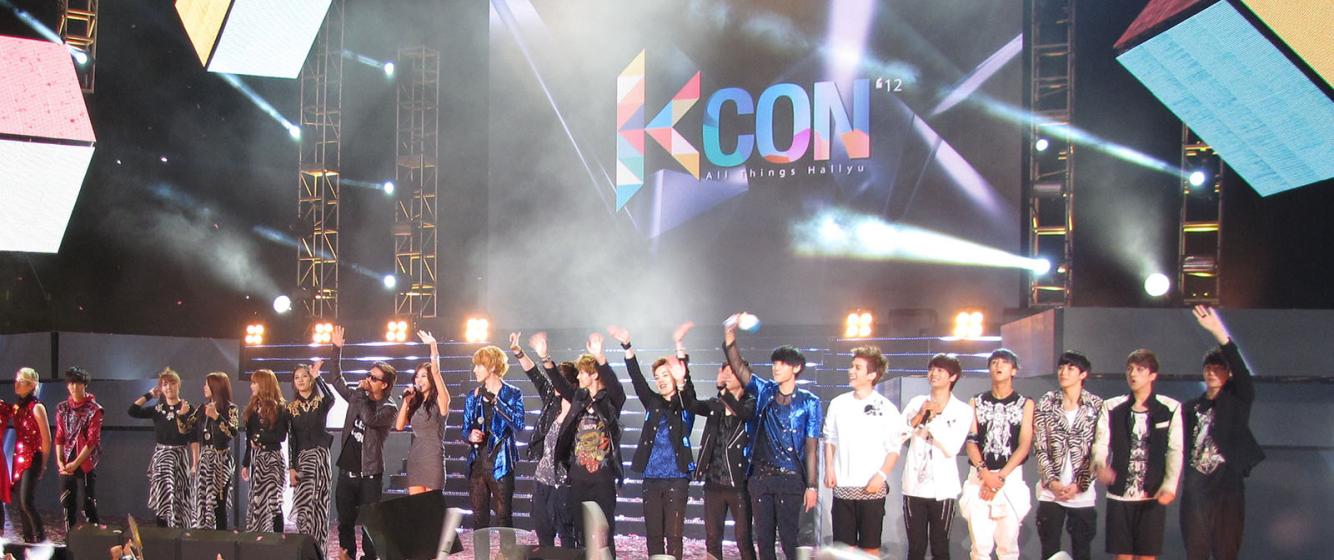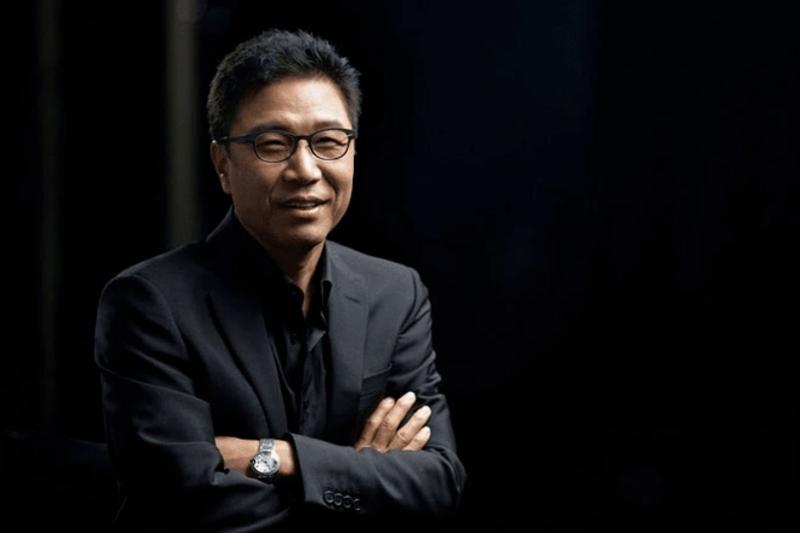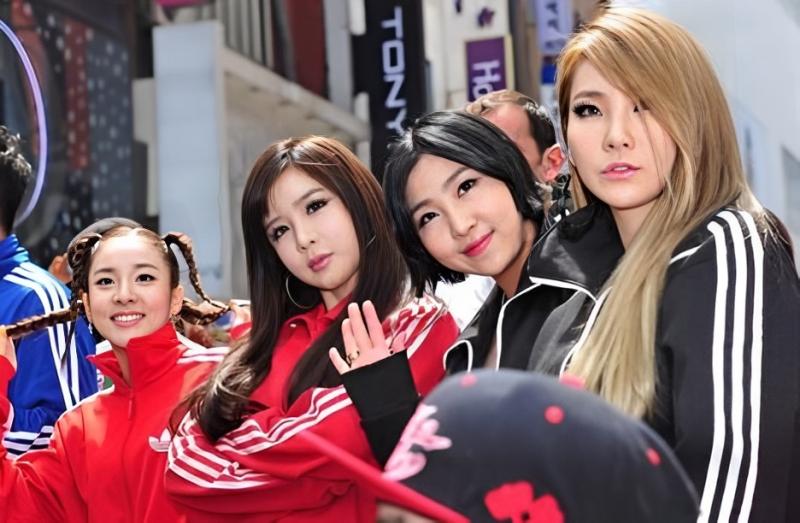
K-pop idol groups on stage at KCON 2012. KCON is an annual music festival held in locations across the world, to promote K-pop, and shows the popularity of the genre. Peter Kaminski from San Francisco, California, USA - KCON 2012
What is J-pop and K-pop? (part 2) - K-pop innovations REMIX
K-pop fans go crazy when a male idol rips off his shirt to display his rippling “chocolate abs” (six-pack abs) and starts gyrating his hips. Or fans get together to film themselves dancing in public to routines similar to those in music videos by groups like LE SSERAFIM’s “Fearless” (2022). Or fans in Japan go to karaoke rooms to sing the Japanese versions of songs like BTS’ “'I NEED U (Japanese Ver.)” (2017). These behaviors bear evidence of how J-pop and K-pop had diverged by the 2010s. K-pop was built on the Japanese model in the 1990s, but it plowed ahead on its own trajectory in the 2000s with the rise of the digital age. Four key features of K-Pop stand out: synchronized dance, visual appeal, digital engagement, and localization.
The K-pop/J-pop divergence of the 2000s
As we saw in part 1 of “What is K-pop and J-pop,” K-pop was based on the innovations by J-pop producers and artists. We learned that the term “J-pop“ was invented in the late 1980s to describe a highly American or European sounding music with Japanese lyrics, but it had soon broadened in the 1990s to include idol pop, Eurobeat dance music, rap, and rock.
As I pointed out in a previous post, Aja Romano offers an excellent introduction to K-pop. Read this article to get an in-depth look at the elements of K-pop. I will stress that much of K-pop’s success was built upon innovations that Japanese artists had pioneered. However, innovative Korean companies developed the J-pop concepts and took them to a whole different level.
It is commonly said that K-pop began in 1992 with the debut of Seo Taiji and Boys, a hip hop trio whose members shocked Korea with their brash rapping, lyrics critical of society, African American street fashions, and hip-hop dancing. Seo’s music reflected the feelings of the sinsedae, a new generation of Korean youth raised in a prosperous, consumerist Korea but under intense pressures to succeed in school or facing social issues like bullying. Starting with Seo Taiji, it is important to emphasize how much of early K-pop invoked African American culture. In the late 1990s, Korean Americans (usually from Southern California where they learned about Black culture and incorporated much of it into their own style) came to Korea to become performers of their version of rap and R&B.
This form of Americanized music gained such popularity in Korea that music journalist Cho Hyun-Jin used the term “K-pop” to describe it in 1999 to Billboard Magazine. Still, in 2000, very little distinguished K-pop from J-pop. Take a look at the J-pop girl quartet, SPEED, and the group’s charisma and stage presence while dancing at international locations in “Body and Soul” (1997):
Now, compare [them] to their Korean contemporaries, S.E.S, which Japanese newspapers called the “Korean Speed.” Not much differentiates them, as you can see from their video, “I’m your girl” (1997):
By the mid 2000s, K-pop had diverged from J-pop to show many stylistic and production differences. The rest of this blog post will look at these divergences.
Dance, dance, dance: Lee Soo Man and the birth of modern K-pop

K-pop began to acquire its distinctive features in the 21st century. By the 2000s, K-pop had become a visual medium meant to be not only listened to but watched. A common origin story starts with Lee Soo Man, a musician who was a graduate student at Cal State Northridge, watching a music video of Michael Jackson in the 1980s and realizing that the future direction of music would involve looks as well as dancing to accompany the singing. Upon returning to Korea, he created SM Entertainment, and his idol groups, H.O.T and S.E.S, featured good-looking idols who could dance and sing.
K-pop groups from SM and other Korean companies began to diverge in the 2000s, in what is known as the “Second generation.” Korean management companies entrusted much of their songwriting to Scandinavian songwriters (referred to as “The Scandinavian pop machine”) to give K-pop a sleek modern dance sound that was both indistinguishable from its Western counterparts and complementary to the beautiful idols. Many K-pop songs incorporated African American influences like hip hop dancing and English rap, often performed by Korean Americans. In fact, American R&B groups like TLC, SWV, New Edition or Boyz II Men imparted much influences on the K-pop sound.
Importantly, to enhance the visual appeal of their groups, Koreans took dance to a whole new level. Ensemble dance became an integral part of K-pop performance, with idols dancing in unison in complex and synchronized choreography. K-pop became a fusion by the mid-2000s of J-pop idol group dancing with the street moves and sensibility of African American hip hop. The resulting hit songs would evolve into having a “dance hook.” This signature move makes the song identifiable and is repeatedly performed throughout the song. Look at SM’s Super Junior’s “Sorry sorry”(2009) which has two signature hooks (First at 0:22, and another hook at 1:14”):
This focus on the dance precision requires teamwork and technique honed through hours of brutal practice. In the model used in American entertainment, the talent is discovered by scouts or through nationwide auditions. Most young Americans would refuse to subject themselves to years of brutal physical training (with the exception of high school sports athletes) to become a performer. In the K-pop industry, music companies (based on the Japanese ones) look for kids as young as ten to commit to the rigorous training required to become pop stars. Thus, the K-pop model – replete with visual and dance-focused demands – requires much from young trainees. Therefore, while Japanese idols by the 2010s focused on cuteness and accessibility, K-pop required that its idols dance in perfect precision.
Visual Appeal of K-pop: Beauty and the Beast

Screenshot of Lee Hyori singing her hit “Ten Minutes” (2003)
Accompanying this significant dance factor, the visual appeal of impossibly beautiful idols became the defining feature of K-pop. As John Lie (2014) points out in his seminal study of K-pop, physical beauty became one of the key features of K-pop. While Japanese companies pioneered the use of glamorous idols who could dance and sing, Korean companies took the visuality of their music to a new level.
Lie identifies DSP Media’s Lee Hyori’s “Ten Minutes”(2003) as the convergence of these trends of dance, hip hop, and visuals. Hyori, a former girl idol, is dressed in provocative (for Korea in 2003) fashions, and the dance moves are choreographed to a dance beat:
SM Entertainment rocketed to worldwide fame using beautiful idols like SNSD (also known as Girls Generation), an idol group whose members enhanced their visual appeal with their long lovely legs as seen in “Genie”(2009).
SM’s DBSK featured handsome male singers with chiseled muscles. Other acts followed from competing agencies, often using plastic surgery to enhance their looks. Male singers – like JYP’s 2 PM, one of the famous “beast idols” of the second generation – proudly showed off their sculpted bodies on TV to the delight of their screaming fans:
Female singers like SISTAR pushed the boundaries of what Korean society then found acceptable through their sexy figures, tight clothing, and provocative dances such as in their signature hit, “Alone” (2017):
Today, the visual beauty of K-pop idols has become so dominant that fans often complain singers lack training and rely mostly on their looks for popularity. Of course, many fans will prioritize a less-skilled singer with beautiful physical appearance and dance skills over a skilled vocalist who may not be as beautiful.
Digital Engagement and the Online genre

A screenshot of a K-Pop in Public online challenge, this time by a Paris-based dance crew.
A third defining feature of K-pop emerged in the 2000s when Korean companies pioneered the extensive use of digital media in the 2000s. The IMF crisis of 1997– in which the Korean economy collapsed, leading to 10% unemployment – taught Koreans the necessity of exports to make up for the small size of the national market. Unlike the Japanese, who had the world’s second largest music market at the time and could prioritize the domestic market, Korean companies had to export their acts. With a unique visual appeal and Americanized sound adapted to the J-pop model, the “Second generation'' K-pop groups ventured into nearby markets like Japan and China through digital technology.
While J-pop, as we saw in the earlier post, was a media ecosystem built on physical sales of CDs backed by TV and commercial appearances, K-pop turned into a media ecosystem based on sales of merchandise and concerts backed by free digital content and especially fan engagement. Korean companies used video sharing sites like YouTube to allow artists to promote their music, interact with fans, and distribute music – why this change? By the 2000s, digital downloading and piracy made it difficult to generate profits from physical CD and DVD sales. Thus, the Korean companies gave away their music for free online, hoping that publicity from the songs would translate to commercial endorsements, concert sales, merchandise sales, and CD purchases.
In fact, digital fan engagement through social media became the definition of K-pop. Fans could meet through bulletin boards to discuss their favorite idols. Many idols today constantly post from social media accounts or run livestreams from their homes, creating a sense of closeness with their fans. Also, these fans often give their own time and money to promote the idol, such as purchasing billboards advertisements, gifting bags of rice at concerts, or repeatedly watching their favorite idol's YouTube videos to drive up the number of views. Additionally, many fans perform dances of their favorite groups in public and share these videos online. Rather than take down this content, Korean companies saw as a free promotion for idol groups. K-pop thus depends on sales and promotion efforts of a small number of highly engaged fans.
Localization: K-pop for the world

Influential group 2NE1 (photo here in 2013) promoted a trend of incorporating idols who were non-Korean or Koreans who lived overseas.
Accompanying the digitization of K-pop was the localization of the groups to optimize their appeal in the world market. As John Seabrook noted in a New Yorker article, Lee Soo Man coined the term “Cultural technology” in the late 1990s to describe his efforts to localize K-pop for exports to different Asian markets. Lee and his colleagues produced a manual of cultural technology cataloguing how to localize K-pop artists to different Asian countries, such as camera angles in a video, chord progressions to use in what country and even the color of eyeshadow a performer should wear for a particular country.[1]
One way of localizing is releasing versions of the song in different languages, most commonly Japanese. For example, BTS released “Japanese versions” of their songs to appeal to the lucrative Japanese market. Take a look at the side-by-side comparison of the Korean language and Japanese version of “Mic Drop” (2017):
Another way is to use non-Korean members in groups. While first-generation groups incorporated Korean Americans to give their groups American “authenticity” to Korean audiences, the second-generation groups included non-Koreans or overseas Koreans in their groups to increase their overseas appeal. For example, YG Entertainment’s influential four-member girl group, 2NE1 (2009 - 2016), had three members with considerable overseas experience: Dara, from the Philippines, Park Bom, a Korean who grew up in the US, and CL (Lee Chae-rin), a Korean who spent her formative years in France and Japan. Only Minzy (Gong Min-ji) was born and raised in Korea.
After 2NE1 disbanded in 2016, YG recreated the same formula with the four member girl group BLACKPINK, with Rosé (Roseanne Park), who came from New Zealand, Jenny (Jennie Kim), who spent her middle school years in New Zealand, and Lisa (Lalisa Manobal), who hailed from Thailand. Only, Jisoo (Kim Ji-soo) is a native of Korea.
And the formula continues. YG’s newest group, BabyMonster, who debuted in 2023, has seven members, with only three Koreans, and for international appeal, two Japanese and two Thai members.
Thus, sometimes very little is “Korean” about K-pop groups, except that they sing some lyrics in Korean to differentiate themselves from other forms of music.
J-pop vs K-pop is like Pepsi vs Coke
My colleague, Pat Patterson pointed out that little distinguishes world pop music from each other. So what distinguishes K-pop and J-pop? He pointed out that the distinction comes in brand identity – such as the visuals, dancing, language, or impossible beauty standards. These elements define a brand, rather than a deep cultural difference from other musical traditions. Thus K-pop and J-pop are brands of similar products packaged differently, and promoted through different media ecosystems.
It is kind of like how people argue whether Coke or Pepsi is better.
K-pop and J-pop are national labels for a transnational phenomenon: the Pop Pacific. Rather than look at stylistic or musical characteristics, the series of blog posts will examine K-pop and J-pop as transnational cultural products, the result of historical interactions among Korea, Japan,]and the U.S throughout the 20th and 21st centuries. As you will see, J-pop reveals a history of Japan’s coming to terms with American bases in a defeated nation in the late 1940s and 1950s, issues of a growing consumerist economy in the 1960s to 1980s, and a nation struggling with economic stagnation in the 1990s and beyond. K-pop will provide a glimpse of a Korea struggling with the postcolonial issues: from liberation from Japanese rule and the establishment of a heavy US military presence in the 1950s, economic growth under a dictatorship in the 1960s to 1980s, and a post-dictatorship democracy struggling with issues of generational change.
A special thanks to Dr. Sharon Woodlief (sharonwoodliefphd@gmail.com) for helping to edit this work and providing feedback. She offers a professional editing service, and I highly recommend her if you are having trouble with your article, theses, or dissertation.
Read part 3 of this series, to see how K-pop has become a transnational music.
[1] John Seabrook, “Factory Girls,” The New Yorker, October 1, 2012, https://www.newyorker.com/magazine/2012/10/08/factory-girls-2.
Discussion Questions
- What are the four key features that distinguish K-pop from J-pop by the 2000s?
- How did K-pop’s use of synchronized dance and “dance hooks” change the way pop music is performed and consumed worldwide?
- The article describes K-pop idols undergoing years of intense training, starting as children. What are the benefits and drawbacks of this system?
- Many K-pop groups include non-Korean members to appeal to global fans. Does this make K-pop more “international,” or does it risk losing its cultural identity?
- The article compares K-pop and J-pop to Pepsi and Coke, suggesting the difference is more about branding than music. Do you agree? Can you think of other examples in pop culture where brand identity is more important than the actual product?
- K-pop and J-pop are presented as part of a larger “Pop Pacific,” a transnational cultural exchange. How does this perspective change the way we think about national vs. global culture?
Add new comment